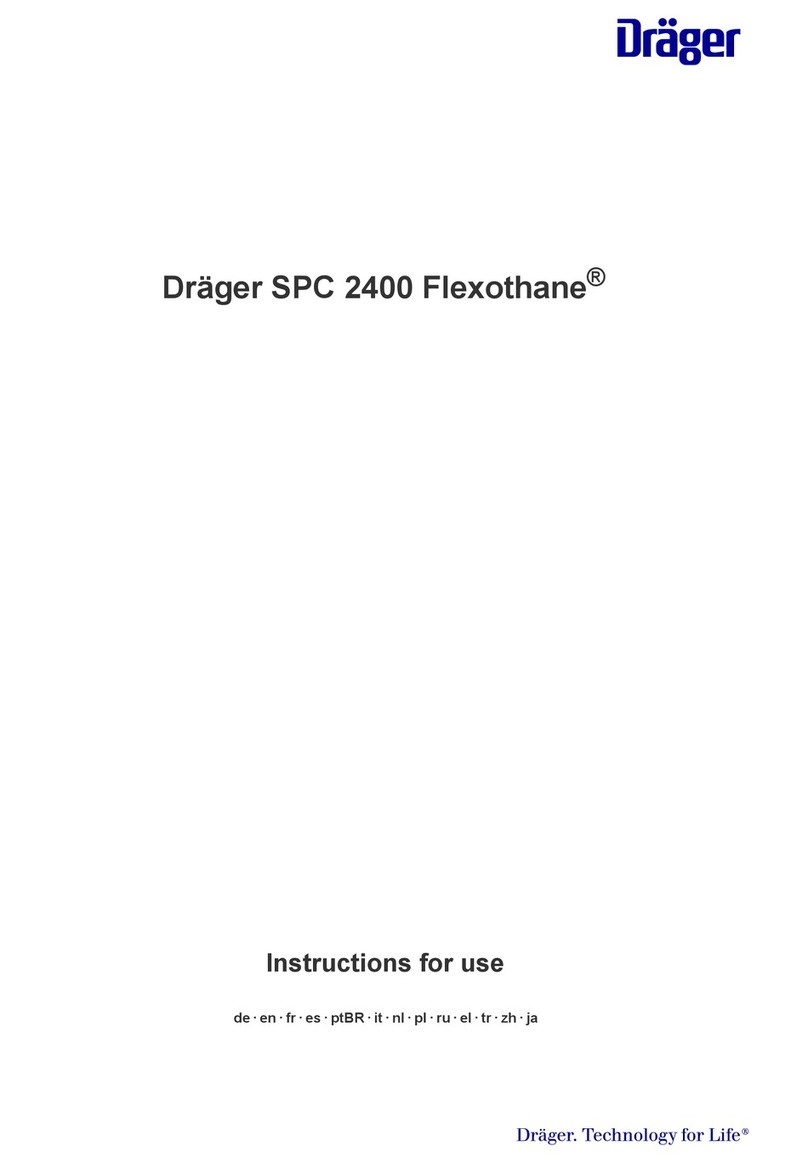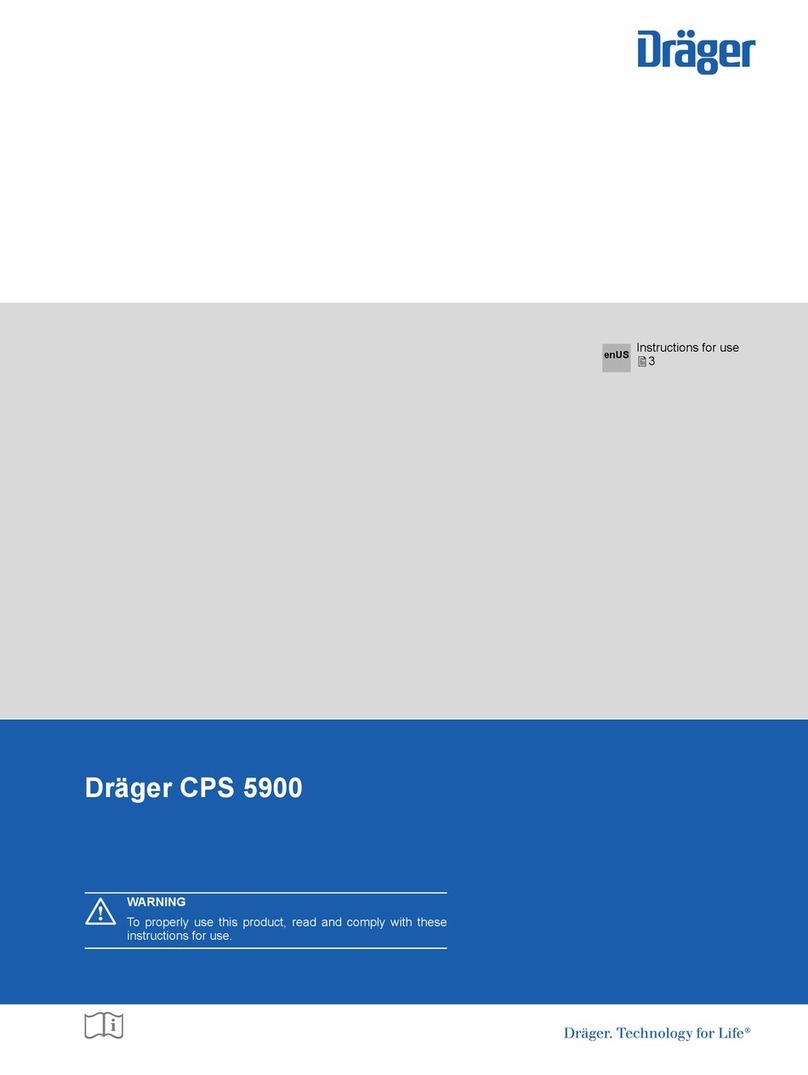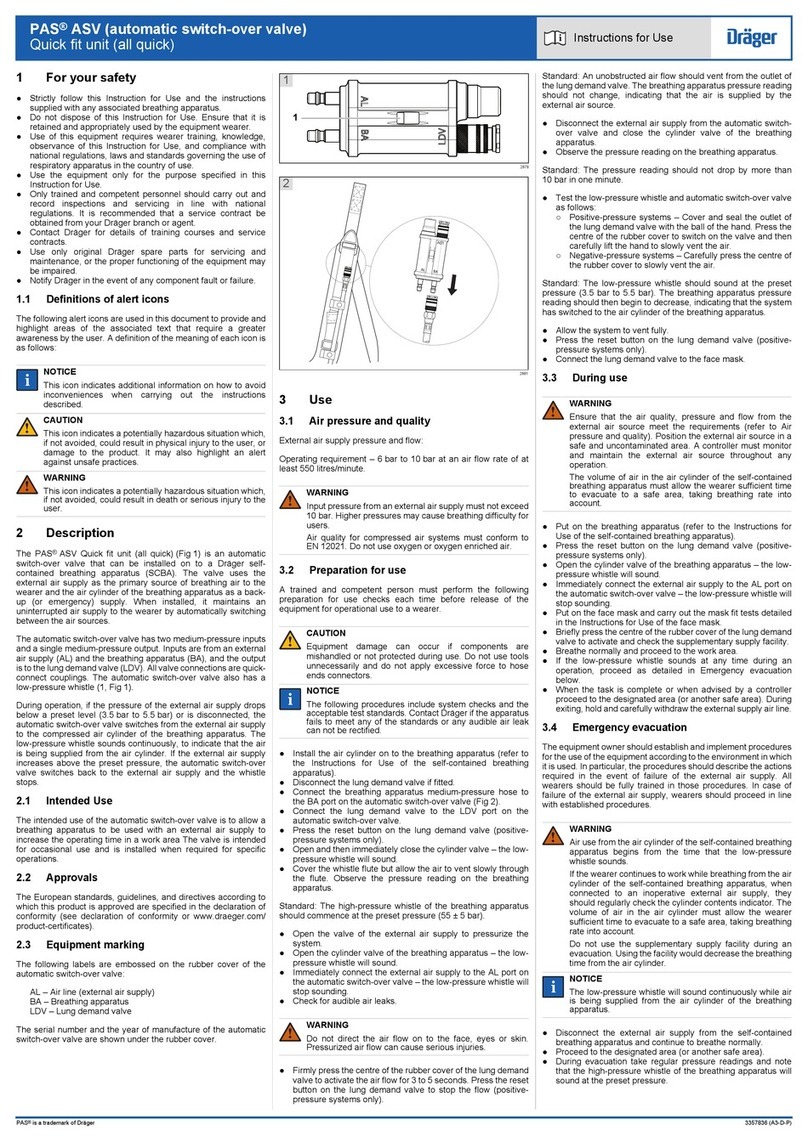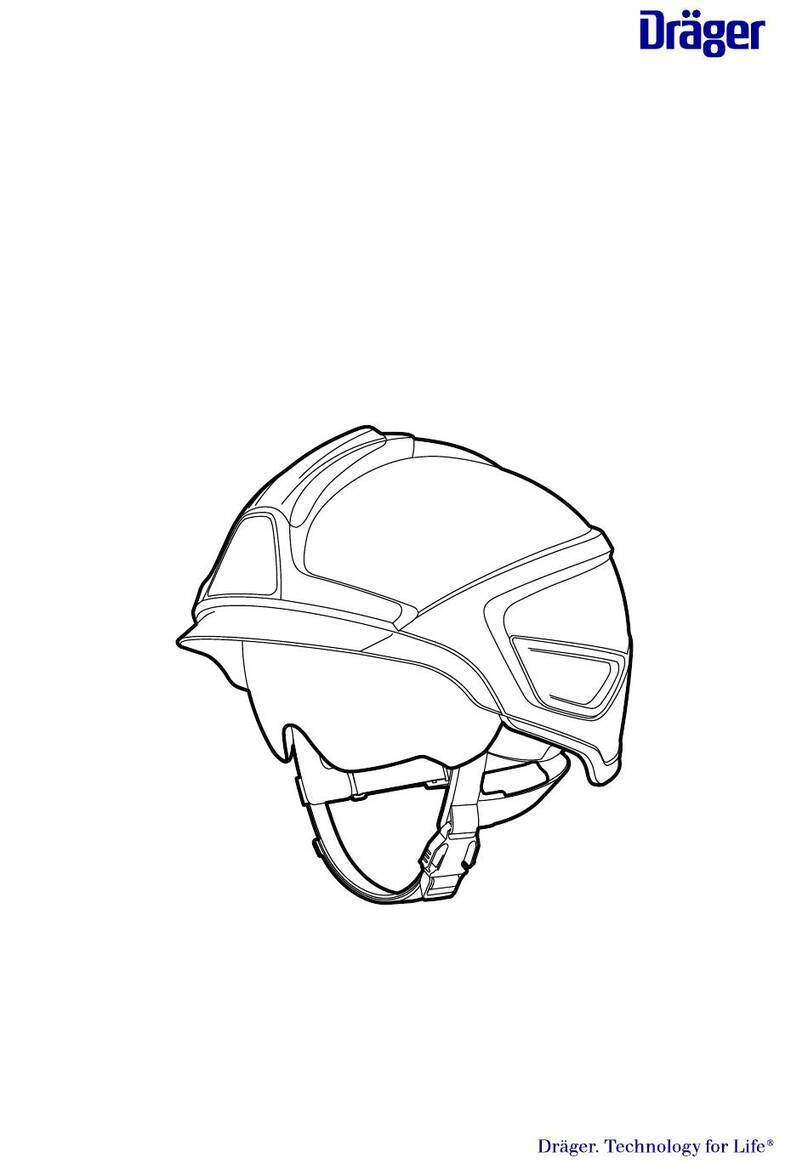
PSS®and Bodyguard®are registered trademarks of Dräger 3358298 (A3-D-P) 1 / 3
3358298
© Dräger Safety UK Limited
Edition 07 – August 2019 (Edition 01 – December 2009)
Subject to alteration
Draeger Safety UK Limited
Ullswater Close Tel +44 1670 352 891
Blyth, NE24 4RG Fax +44 1670 356 266
United Kingdom www.draeger.com
PSS®5000 Series
Self-contained breathing apparatus Instructions for use
1 For your safety
1.1 General safety statements
●Before using this product, carefully read the Instructions for Use.
●Strictly follow the Instructions for Use. The user must fully understand
and strictly observe the instructions. Use the product only for the
purposes specified in the Intended Use section of this document.
●Do not dispose of the Instructions for Use. Ensure that they are
retained and appropriately used by the product user.
●Only fully trained and competent users are permitted to use this
product.
●Comply with all local and national rules and regulations associated
with this product.
●Only trained and competent personnel are permitted to inspect, repair
and service the product. Dräger recommends a Dräger service
contract for all maintenance activities and that all repairs are carried
out by Dräger.
●Properly trained service personnel must inspect and service this
product as detailed in the Maintenance section of this document.
●Use only genuine Dräger spare parts and accessories, or the proper
functioning of the product may be impaired.
●Do not use a faulty or incomplete product, and do not modify the
product.
●Notify Dräger in the event of any component fault or failure.
●The air supply shall meet the requirements for breathing air according to
EN12021.
1.2 Definitions of alert icons
Alert icons are used in this document to provide and highlight text that
requires a greater awareness by the user. A definition of the meaning of
each icon is as follows:
WARNING
Indicates a potentially hazardous situation which, if not avoided,
could result in death or serious injury.
CAUTION
Indicates a potentially hazardous situation which, if not avoided,
could result in physical injury or damage to the product or
environment. It may also be used to alert against unsafe practices.
NOTICE
Indicates additional information on how to use the product.
2 Description
2.1 Product overview
The Dräger PSS®5000 Series is a self contained breathing apparatus
(SCBA) that uses an open-circuit breathing system. The series is
compatible with a wide range of compressed-air cylinders, face masks and
lung demand valves (e.g. FPS 7000 and Panorama Nova face masks, PSS
Series lung demand valves, and steel or composite cylinders).
The apparatus can also be fitted with a multi-function electronic monitoring
system (e.g. Bodyguard®7000). Refer to the relevant Instructions for Use
for the description, operation and testing of electronic systems.
2.2 Feature description
The carrying system has a carbon-composite backplate, with adjustable
shoulder straps and waist belt connected using quick release connectors.
A waist pad (Fig 1, Item 6) connected at a flexible joint compensates for
the twisting and bending of the user. Cylinder mounting systems include a
single cylinder strap (2) or a universal cylinder strap for use with twin
cylinders.
The apparatus uses the Dräger high-performance pressure reducer (4)
that reduces cylinder pressure and supplies breathing air through a
medium-pressure hose (5) and coupling (1) to the attached lung demand
valve. A dual-pressure hose (3) supplies air to the whistle when it is
activated, and has an internal capillary tube that supplies high-pressure air
from the cylinder to the gauge. Air hoses and modular components of the
monitoring system are integrated into the backplate to prevent snagging
and enhance component protection.
Compressed air cylinders, lung demand valves and face masks
The Dräger PSS 5000 Series is compatible with steel or composite
material cylinders of 4 to 9 litre capacities, and 200 or 300 bar pressure.
Full descriptions and user instructions are contained in separate
instructions supplied with the cylinder, mask or lung demand valve.
2.3 Intended use
The Dräger PSS 5000 Series breathing apparatus, when fitted with a
cylinder, lung demand valve and face mask, is intended for use by
emergency services and in industrial applications where a high level of
respiratory protection is required. The assembled breathing apparatus
provides the wearer with respiratory protection for working in contaminated
or oxygen-deficient conditions, and is suitable for fire fighting.
The cylinder, lung demand valve, face mask and other accessories used
with this product must be certified Dräger components, assembled in an
approved configuration. Contact Dräger for further information.
Use in potentially explosive atmospheres
The PSS 5000 Series is type tested as suitable for use in potentially
explosive atmospheres. Electronic sub-assemblies are ATEX certified.
All combinations are suitable for use in hazardous areas up to and
including zone 0 and zone 20.
2.4 Approvals
The European standards, guidelines, and directives according to which
this product is approved are specified in the declaration of conformity (see
declaration of conformity or www.draeger.com/product-certificates).
!
!
2.5 Explanation of marking and symbols
Refer to the relevant authority for explanation of approval body symbols
and marking on the equipment. Examples of other marking on component
parts of the breathing apparatus are:
BRAC-1359 – Dräger serial number
08/09 – Month and year of manufacture
3356812 or R21034 – Dräger part number
SF – Standard force coupling
LF – Low force coupling
3 Use
WARNING
Only trained and competent personnel may prepare and use
breathing apparatus. Ensure that any accessories, ancillary
equipment and other protective clothing items do not interfere with
the apparatus and do not create a safety hazard.
The effective working duration of the apparatus is dependent on
the initial air supply available and the breathing rate of the wearer.
Fill all air cylinders to their full rated pressure prior to use, and do
not commence any operation using a cylinder that is less than
90 percent full (or greater when national regulations dictate).
CAUTION
Do not apply excessive force or use tools to open or close a
cylinder valve, and do not drop or throw down the breathing
apparatus.
3.1 Preparation for use
NOTICE
The face of the pressure gauge may be fitted with a thin flexible
protective covering. Remove this covering before first use.
1. Carry out a visual inspection of the apparatus (see Section 3.5.1).
2. Fit the air cylinder (see Section 3.5.2).
3. For breathing apparatus with a medium-pressure coupling for the lung
demand valve, disconnect and then reconnect the male coupling. To
connect, press the male coupling into the female coupling until an
audible click is heard. If there is any difficulty disconnecting or
connecting, see the troubleshooting information in Section 4.
4. Press the reset button when using a positive-pressure lung demand
valve (see the Instructions for Use supplied with the lung demand
valve).
5. Carry out a full functional test of the apparatus (see Section 3.5.3).
6. Connect the lung demand valve to the face mask and check the
security of attachment by gently attempting to pull the coupling apart.
3.2 Putting on the breathing apparatus
1. Fully loosen the shoulder straps and waist belt and put on the breathing
apparatus.
!
2. Check that the shoulder pads are not twisted and take the weight of the
system on the shoulders by pulling the shoulder straps. Do not fully
tighten at this stage.
3. Close the waist belt buckle and pull the ends of the waist belt forward
until the strap padding fits securely and comfortably over the hips
(Fig 2). Tuck the belt ends behind the waist pad.
4. Pull the shoulder straps until the breathing apparatus rests securely
and comfortably on the hips. Do not over tighten. Pull the strap
retainers down to secure the strap ends (Fig 3).
5. Fully loosen the head straps of the face mask and place the neck strap
over the back of the neck.
6. Press the reset button when using a positive-pressure lung demand
valve.
7. Open the cylinder valve slowly, but fully, to pressurize the system (if
two cylinders are fitted, fully open both cylinder valves).
8. Put on the face mask and check for tight fit (see the Instructions for Use
supplied with the mask).
3.3 During use
WARNING
Fully open all cylinder valves and ensure that they remain open
during use.
Users should be in a safe area before the whistle warning
commences. Evacuate to a safe area immediately if warnings
commence during an operation.
Using the supplementary air supply will use air from the cylinder
and rapidly reduce the working duration of the apparatus.
●Regularly check the remaining cylinder pressure on the gauge.
●If supplementary air is required, briefly press the rubber cover at the front
of the lung demand valve to deliver extra air into the face mask..
3.4 After use
WARNING
Do not remove the breathing apparatus until in a safe breathing
environment.
1. Loosen the face mask straps. As the seal to the face is broken, press
the reset button when using a positive-pressure lung demand valve.
Remove the face mask.
2. Close the cylinder valve or valves.
3. Press the rubber cover at the front of the lung demand valve to vent
the system fully. Press the reset button when using a positive-pressure
lung demand valve.
4. Release the waist belt buckle.
5. Lift the shoulder strap ends to release the strap retainers (Fig 3) and
then lift the shoulder strap buckles to loosen the straps.
6. Remove the breathing apparatus and face mask.
7. Remove the air cylinder (see Section 3.5.2) if required.
8. Carry out the after use tasks in the maintenance table (see Section 5).
9. Pass the breathing apparatus to the service department with details of
any faults or damage that occurred during use.
3.5 Common user tasks
3.5.1 Visual inspection
A visual inspection must check the full breathing apparatus including all
component parts and accessories. Check that the equipment is clean and
undamaged, paying particular attention to pneumatic components, hoses
and connectors. Typical signs of damage that may affect the operation of
the breathing apparatus include impact, abrasion, cutting, corrosion and
discolouration. Report damage to service personnel and do not use the
apparatus until faults are rectified.
3.5.2 Air cylinder fitting and removing
WARNING
High-pressure air release may cause injury to the user or other
personnel near the breathing apparatus. Close the cylinder valve and
fully vent the system before attempting to disconnect an air cylinder.
Impact damage to the cylinder valve or reducer connector may
prevent valve connection or cause an air leak. Handle the air
cylinder and breathing apparatus with care.
NOTICE
For other cylinder connector types, refer to the Instructions for Use
supplied for the connector.
Fitting a single cylinder with a threaded connector
1. Check the threads of the cylinder valve port and the pressure reducer.
Ensure that the O-ring seal (Fig 4, Item 1) and the sintered filter (2) in
the reducer are clean and undamaged.
2. Lay the backplate horizontal, with the reducer uppermost, and fully
extend the cylinder strap.
3. Insert the cylinder through the loop of the strap, and align the valve with
the reducer.
4. Lift the cylinder and backplate into the vertical position (supported on
the end of the cylinder opposite the valve).
5. Tighten the hand wheel of the reducer, using only the thumb and index
finger, until a definite metal-to-metal contact is felt. Do not use tools or
over tighten.
6. Place the unit back into the horizontal position.
7. Take up the slack in the cylinder strap (Fig 5).
8. Pull the strap over the cylinder to operate the cam lock (Fig 6) and
secure using the hook-and-loop fastening.
Removing a single cylinder with a threaded connector
1. Close the cylinder valve and fully vent the system.
2. Lay the backplate horizontal, with the cylinder uppermost.
3. Remove the free end of the cylinder strap from the hook-and-loop
fastening.
4. Lift the strap against the cam lock to release the buckle tension and
loosen the strap.
5. Disconnect the cylinder valve from the pressure reducer.
6. Lift the cylinder away from the reducer and remove the cylinder.
!
!
!












































